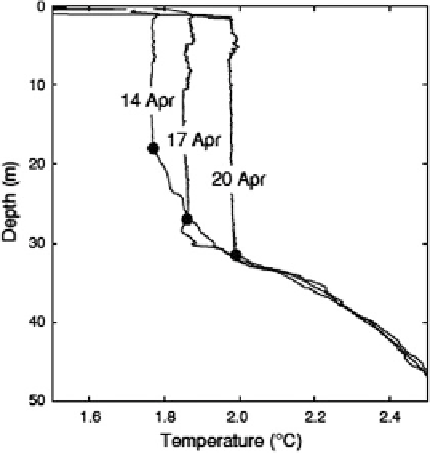Geoscience Reference
In-Depth Information
where
is the thickness of the surface boundary layer, and H is the
depth of the convective layer. Accordingly, the velocity scale w* is a measure of the
kinetic energy of the convective motions and is representative for both the root-mean-
square (rms) velocity u
rms
of vertical convective water motions and the rate of the mixed
layer deepening. The rms velocity was estimated from large eddy simulations as 0.7w*by
Mironov et al. (2002). Typical reported u
rms
physical values are 2
ʒ
is the buoyancy
fl
ux,
ʴ
3mms
−
1
(Farmer
-
1975; Kelley 1997) and support the above scaling.
The rate of deepening of a convective mixed layer is approximately given by (see
Kirillin et al. 2012b)
dt
¼
0
:
2
w
3
dH
ð
7
:
31
Þ
H
D
b
where
b is the buoyancy jump at the bottom of the mixed layer. The reported rates of the
mixed layer deepening are typically
ʔ
0.5 m day
−
1
and increase up to several meters per
day in deeper lakes. The background strati
*
cation enters into Eq. (
7.31
) through the
ʔ
buoyancy jump
uences on the convective layer
development. A case with very fast development was registered in Lake P
b. Therefore the past winter history in
fl
ää
ä
rvi, Finland,
in sunny weather in April 2011 after relatively long snowy winter (Fig.
7.12
). As a result,
a large amount of radiation penetrating into a weakly stratified water column deepened the
mixed layer at the rate of more than 3 m day
−
1
. Then, a sharp temperature gradient at the
bottom of the mixed layer was then produced, increasing the term (H
ʔ
b) in Eq. (
7.31
), and
the deepening rate reduced to about 1 m day
−
1
.
j
Fig. 7.12
Convective
temperature profiles in the
central part of Lake P
ää
j
ä
rvi,
spring 2011 (Kirillin et al.
2012a). Dots mark approximate
locations of the convectively
mixed layer



Search WWH ::

Custom Search